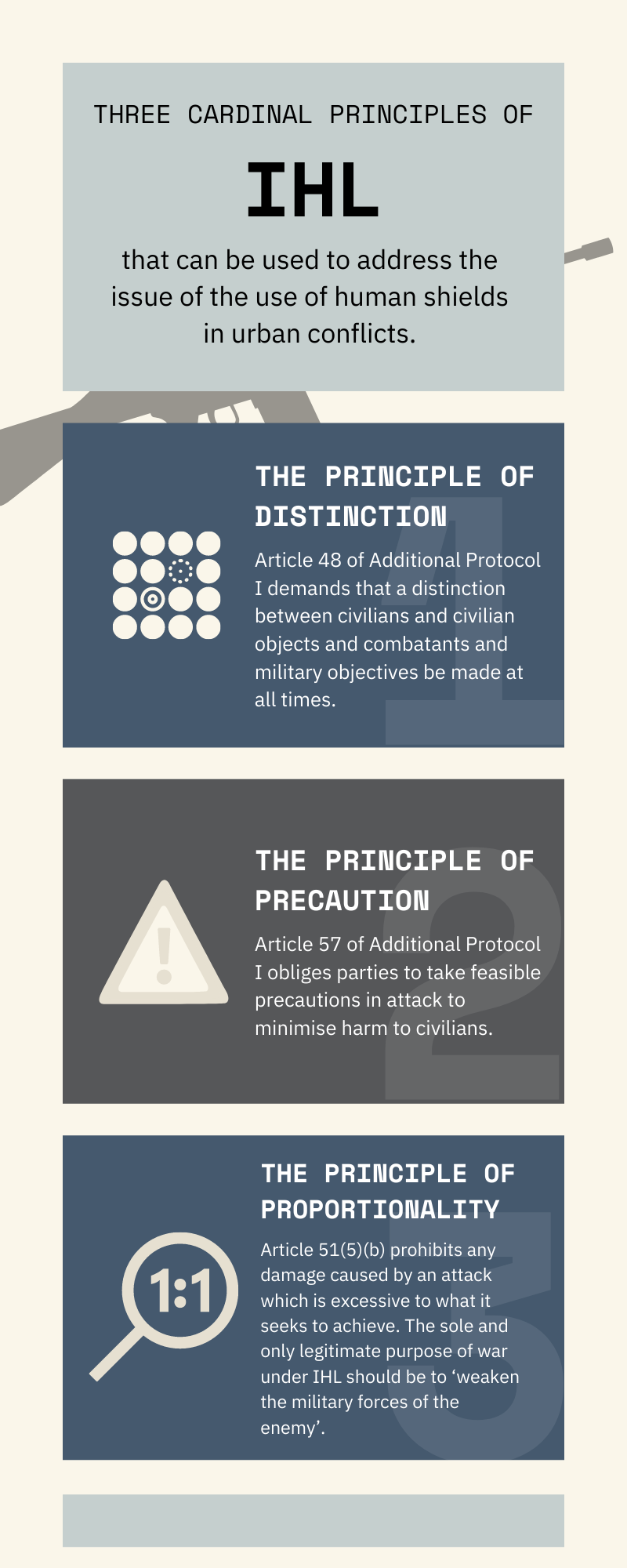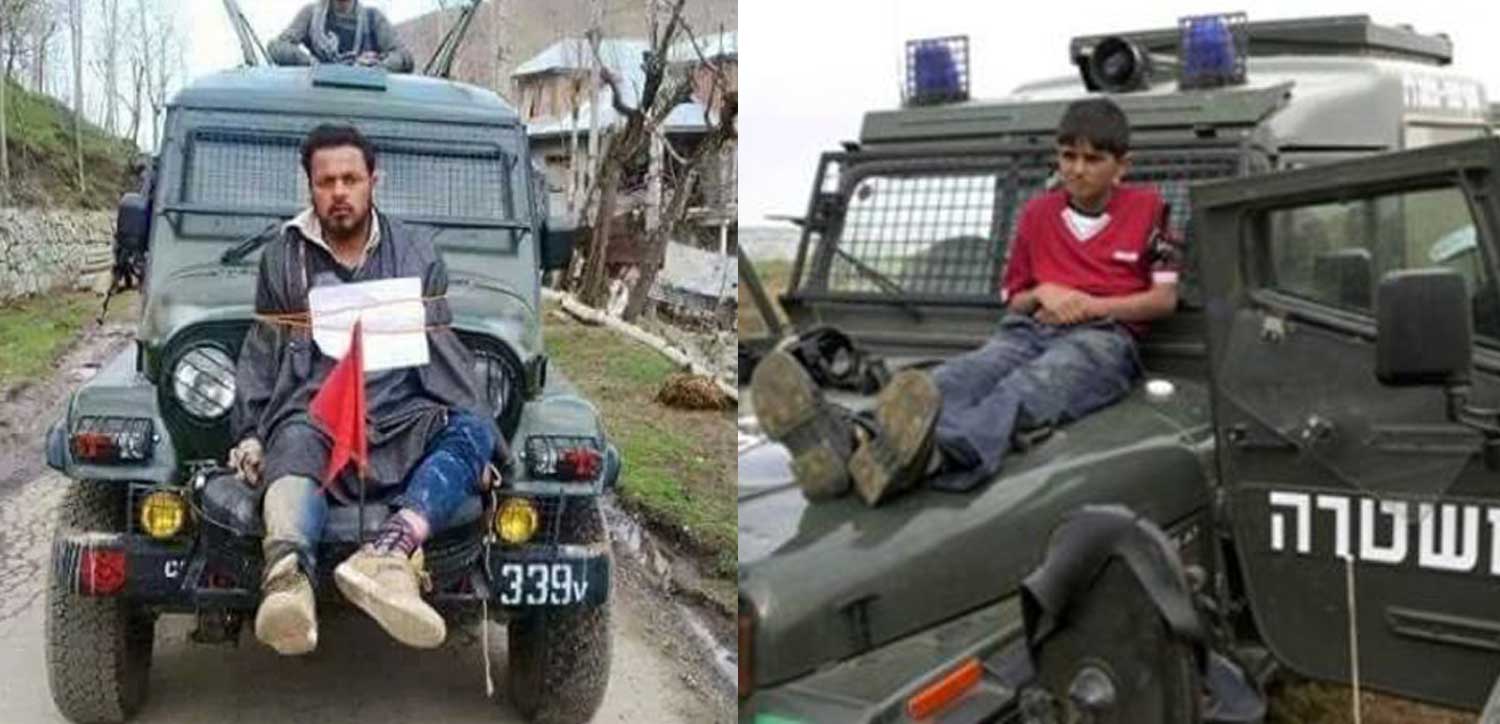Human Shields in Urban Conflicts
|
Getting your Trinity Audio player ready...
|
Introduction
Human Shields under International Humanitarian Law
Human shielding is the use of protected persons, such as prisoners of war and civilians, to impede attacks on combatants and military objectives.1Schmitt, Michael N. “Human Shields in International Humanitarian Law.” Columbia Journal of Transnational Law, vol. 47, no. 2, 2009, p. 292-338. It is prohibited under international humanitarian law with Article 51(7) of Additional Protocol I stating that:
The presence or movement of the civilian population or individual civilians shall not be used to render certain points or areas immune from military operations, in particular in attempts to shield military objectives from attacks or to shield, favour or impede military operations. The Parties to the conflict shall not direct the movement of the civilian population or individual civilians in order to attempt to shield military objectives from attacks or to shield military operations.
It is also found in Article 23(1) of the Third Geneva Convention as it relates to prisoners of war and Article 28 of the Fourth Geneva Convention which relates to civilians. The International Committee of the Red Cross has confirmed that this prohibition is customary international humanitarian law applicable in both international and non-international armed conflicts.2 “Practice Relating to Rule 97. Human Shields.” Customary IHL – Practice Relating to Rule 97. Human Shields, https://ihl-databases.icrc.org/customary-ihl/eng/docs/v2_rul_rule97. These prohibitions are complemented by Article 58 of Additional Protocol I, which obliges parties to the conflicts to take, to the maximum extent feasible, precautions to remove the civilian population, individual civilians and civilian objects from the vicinity of military objectives; to avoid locating military objectives within or near densely populated areas; and to take other necessary precautions to protect the civilian population, individual civilians and civilian objects under their control against the dangers arising from military operations. Using human shields to render points, areas or military forces immune from military operations is a war crime under Article 8.2(b)(xxiii) of the Rome Statute.
The ICRC Casebook describes the term ‘human shields’ as a warfare method prohibited by IHL which makes use of the involuntary or voluntary presence or movement of civilians to guard or immunize military targets from attack by the opposite party which would be bound by various laws of IHL. This includes, and indeed the prohibition on the use of human shields is ancillary to, Article 48 of the Additional Protocol I which states that parties to a conflict are to distinguish between civilians and combatants at all times and ensure that their attacks are proportional to the military objective that is to be gained.3 “Human Shields.” Human Shields | How Does Law Protect in War? – Online Casebook, https://casebook.icrc.org/glossary/human-shields. H. Victor Condé elaborates upon this definition to explain that human shields are the placement of civilians by a conflicting party between themselves and the adversary to deter attacks by using the adversary’s fear of harming ‘unarmed shields’.4Condé H. Victor. A Handbook of International Human Rights Terminology. University of Nebraska Press, 199 He further explains that these shields are in reality ‘hostages used for strategic purposes.5Id. At 6 The use of human shields is often compared with the taking of hostages which is prohibited under Rule 96 of the ICRC’s study of customary humanitarian law and Common Article 3 of the Geneva Conventions.6“Rule 96. Hostage-Taking.” Customary IHL – Rule 96. Hostage-Taking, https://ihl-databases.icrc.org/customary-ihl/eng/docs/v1_rul_rule96. The Statute of the International Criminal Court, regarding both international and non-international conflicts, renders the taking of hostages as a war crime.7 Id. at 3. ICC Statute, Article 8(2)(a)(viii) and (c)(iii)
Principles of Proportionality, Precaution, and Distinction under IHL

The Principle of Distinction
Conflicting parties must ensure that no civilians or civilian objects are targeted in an attack. The principle of distinction, enshrined in Article 48 of Additional Protocol I, demands that a distinction between civilians and civilian objects and combatants and military objectives be made at all times. Military objectives are those objects which ‘by their nature, location, purpose, or use make an effective contribution to military action’.8“Rule 8. Definition of Military Objectives.” Customary IHL – Rule 8. Definition of Military Objectives, https://ihl-databases.icrc.org/customary-ihl/eng/docs/v1_rul_rule8. Accordingly, conflicting parties are only to target attacks at military objectives and refrain from indiscriminate attacks at all times. This particularly applies to urban conflicts where fighters are living alongside civilians, sometimes even as neighbors, which increases the likelihood of civilians being killed due to either an illegal indiscriminate attack or becoming incidental casualties to a lawful attack on a military objectives.
However, civilians lose their protection from attack for so long as they are taking a direct part in hostilities. This loss of protection occurs either through direct participation in hostilities or when ‘they become members of an organized armed group belonging to a party in an armed conflict’.9Melzer, Nils. “Interpretive Guidance on the Notion of Direct Participation in Hostilities under International Humanitarian Law.” International Review of the Red Cross, vol. 90, no. 872, 2008, pp. 27–28., https://doi.org/10.1017/s1816383109000319. Unfortunately, though, ‘direct’ participation in conflict has not been explicitly defined under IHL. Instead, it is deduced in good faith as per the context of the purpose and object.10Id. at pp.41. Direct participation would therefore refer to acts which by their nature or their purpose have the potential to harmfully impact the personnel or equipment of the enemy’s armed forces.11 Sheikh, Maira, and Mughees Uddin Khan. Understanding International Humanitarian Law: A Primer on IHL and Pakistan’s Domestic Law. pp. 73. RSIL, 2017.
The Principle of Precaution
Article 57 of Additional Protocol I obliges parties to take feasible precautions in attack to minimise harm to civilians. Those who are strategizing the attack are to ascertain that the objective is strictly a military one and does not target civilians or civilian objects i.e. buildings, schools, hospitals, etc.12 “Article 57(2)(a).” Treaties, States Parties, and Commentaries – Additional Protocol (I) to the Geneva Conventions, 1977 – 57 – Precautions in Attack, https://ihl-databases.icrc.org/ihl/WebART/470-750073 This can include the dropping of leaflets to urge civilians to leave an area or site which is about to be attacked.
The Principle of Proportionality
The law of war in no way puts an absolute restriction on the loss or damage to civilian life and objects. Instead, international humanitarian law requires that a balance is struck between the damage an attack may cause to civilians or civilian objects and the military advantage expected to be gained. In this regard, Article 51(5)(b) prohibits any damage caused by an attack which is excessive to what it seeks to achieve. The sole and only legitimate purpose of war under IHL should be to ‘weaken the military forces of the enemy’.13“Declaration Renouncing the Use, in Time of War, of Explosive Projectiles Under 400 Grams Weight.” Treaties, States Parties, and Commentaries – St Petersburg Declaration Relating to Explosive Projectiles, 1868 – Declaration -, https://ihl databases.icrc.org/applic/ihl/ihl.nsf/Article.xsp?action=openDocument&documentId=568842C2B90F4A29C12563CD0051547C
Complexity of Human Shields in Urban Conflicts
With the urbanization of conflicts and the change in the nature of warfare, conflicts now primarily take place between non-state actors, terrorist organizations, or insurgent groups, and state actors or a single government.14 Lele, Ajey. “Asymmetric Warfare: A State vs Non-State Conflict.” Institute for Defense Studies and Analyses, Dec. 2014. file:///C:/Users/HP/Downloads/Dialnet-AsymmetricWarfare-5134877.pdf The vast disparity between the resources and organization of non-state actors and state actors has made modern warfare asymmetric due to which some non-state actors have been accused of employing civilians as human shields.15 Rubenstein, Amnon, and Yaniv Roznai. “Human Shields in Modern Armed Conflicts: The Need for a Proportionate Proportionality.” Stanford Law and Policy Review, no. 93, 2011, https://doi.org/https://law.stanford.edu/wp-content/uploads/2018/03/rubinstein_roznai.pdf. Moreover, since urban conflicts are increasingly characterized by ethnonational, religious, or ideological insurgency, civilians may, despite not taking part in direct hostilities, be sympathetic enough to even give refuge to a combatant or cooperate with their motives. In such a scenario, the civilian might end up volunteering to become a human shield. It is this complexity over the misuse of human shields that may give non-state actors the means, by using the civilian population this way, to shield military objectives and stave off otherwise lawful attacks. However, to counteract this, some states and academics argue that such attacks would not be illegal as these civilians are, in fact, human shields being used by the opposite party.16 Gordon, Neve, and Nicola Perugini. “The Fallacy of Israel’s Human Shields Claims in Gaza.” Conflict | Al Jazeera, Al Jazeera, 18 June 2018, https://www.aljazeera.com/opinions/2018/6/18/the-fallacy-of-israels-human-shields-claims-in-gaza.
Arguments over Human Shields in Urban Conflicts
The increase in the number of urban conflicts, characterized by a move towards non-international, asymmetric conflicts, has resulted in a debate as to how the principles of IHL are to be applied to reduce human suffering. Due to the urbanization of conflicts, both parties operate on densely populated urban terrain which makes compliance with the principles of proportionality, distinction, and precaution more difficult. In recent times, while non-state actors have been accused of using human shields to immunise military assets, state actors have been accused of carrying out disproportionate attacks and targeting civilians.
In addition to this, another argument is that the proportionality calculation should not be taken into account when civilians are used as voluntary human shields.17 Id. at 31 Rubenstein and Roznai distinguish between voluntary and involuntary human shields in making this argument:
- Voluntary human shields shield military targets of their own free will,
- Unknowing civilians are merely located near a legitimate target but have neither volunteered nor been coerced into shielding it
- Involuntary human shields meanwhile are coerced into shielding the military target.18Rubenstein, Amnon, and Yaniv Roznai. “Human Shields in Modern Armed Conflicts: The Need for a Proportionate Proportionality.” Stanford Law and Policy Review, no. 93, 2011, https://doi.org/https://law.stanford.edu/wp-content/uploads/2018/03/rubinstein_roznai.pdf
Rubenstein and Roznai assert that voluntary human shields are directly participating in hostilities whereas those who are unknowing or involuntary retain their civilian protection.19 ibid. If there is doubt, a presumption in favour of involuntary shielding is to apply.20ibid. Moreover, they argue that adequate warning is to be given prior to attack, if human shields persist after such a warning, they qualify as civilians directly participating in hostilities and thus would not merit consideration in a proportionality assessment.21ibid. However, this argument is subject to much criticism as it seems to strike the balance further in favour of military necessity than humanitarian considerations. Human shields, whether involuntary or voluntary, remain civilians and their activity does not amount to directly participating in hostilities as they do not pose any direct physical threat. As a result, they should be counted in a proportionality calculation. The ICRC agrees with this position, as their interpretive guidance on the notion states that “[t]he fact that some civilians voluntarily and deliberately abuse their legal entitlement to protection against direct attack in order to shield military objectives does not . . . entail the loss of their protection and their liability to direct attack independently of the shielded objective.”22 ICRC, Interpretive Guidance On The Notion Of Direct Participation In Hostilities Under International Humanitarian Law 56-57 (2009)
Furthermore, there have also been instances in which states have argued that those civilians who did not evacuate the area after being warned of an attack, have ‘volunteered’ to become human shields and thus can be targeted as combatants.23 Sterio, Mileno. “The Gaza Strip: Israel, Its Foreign Policy, and the Goldstone Report.” Case Western Reserve Journal of International Law, 2010, https://engagedscholarship.csuohio.edu/cgi/viewcontent.cgi?referer=https://en.wikipedia.org/&httpsredir=1&article=1193&context=fac_articles. However, this does not accord with the definition of combatants provided by Rule 3 of ICRC under which only those who actually belong to the armed forces are combatants.24 “Rule 3. Definition of Combatants.” Customary IHL – Rule 3. Definition of Combatants, https://ihl-databases.icrc.org/customary-ihl/eng/docs/v1_rul_rule3. Any argument that a civilian becomes a combatant for failing to leave a site after a warning that it would be attacked finds no basis in international law.
Conclusion
The opinions expressed in the articles on the Diplomacy, Law & Policy (DLP) Forum are those of the authors. They do not purport to reflect the opinions or views of the DLP Forum, its editorial team, or its affiliated organizations. Moreover, the articles are based upon information the authors consider reliable, but neither the DLP Forum nor its affiliates warrant its completeness or accuracy, and it should not be relied upon as such.
The DLP Forum hereby disclaims any and all liability to any party for any direct, indirect, implied, punitive, special, incidental or other consequential damages arising directly or indirectly from any use of its content, which is provided as is, and without warranties.
The articles may contain links to other websites or content belonging to or originating from third parties or links to websites and features in banners or other advertising. Such external links are not investigated, monitored, or checked for accuracy, adequacy, validity, reliability, availability or completeness by us and we do not warrant, endorse, guarantee, or assume responsibility for the accuracy or reliability of this information.


